PCH and Pacific Palisades are reopening to the public. Some say it’s too soon

- Share via
Pacific Palisades is reopening to the public this weekend, a move hailed by proponents as an important development in the recovery process, but condemned by some local residents and officials who fear it’s still too soon to allow wide access into the fire-ravaged area.
The California National Guard will withdraw from all checkpoints in Pacific Palisades by 8 a.m. Sunday, meaning the previously closed portions of the neighborhood will be open for general access, according to Los Angeles Mayor Karen Bass.
Pacific Coast Highway will also reopen to the public at 8 a.m. Sunday, with a 25-mph speed limit in place and traffic limited to one lane in each direction between McClure Tunnel in Santa Monica and Carbon Beach Terrace in Malibu to allow repair work to continue. The California Highway Patrol will be on hand to assist with public safety and traffic flow.
While there will no longer be any ID requirements for access on the highway, officials are asking only those with essential business in the area to use PCH.
“We are making sure that the Palisades will be safe as residents access their properties with their insurance adjusters, contractors, tow trucks, moving trucks and more,” Bass said in a statement. “If you do not need to be in the Palisades, don’t be.”
For the first time since the devastating Palisades fire ignited on Jan. 7, all Pacific Palisades residents can now return to their properties.
During a webinar with Bass on Friday, Pacific Palisades residents did not voice opposition to reopening PCH, but they took issue with the general public returning to areas devastated by the Palisades fire — voicing concerns about toxic pollution, public safety, looting and lookie-loos.
L.A. City Councilmember Traci Park, who represents the Palisades and several Westside neighborhoods; and Steve Soboroff, whom Bass appointed as the city’s chief recovery officer two weeks ago, both called the decision to reopen the area “premature.”
“I don’t agree that the Pacific Palisades should be reopened to the general public,” Park said during the webinar. “I just personally don’t think that we’re anywhere near ready for that.”
Bass, however, called the move an important step forward in the rebuilding process, and assured residents that the Los Angeles Police Department would be “visibly and robustly deployed” in the area to prevent crime.
Mayor Karen Bass and chief recovery officer Steve Soboroff said the city would soon hire an outside firm to represent the city’s interests in wildfire relief efforts.
LAPD Chief Jim McDonnell said reopening the area is necessary because the city had been on tactical alert since the start of the L.A. County firestorm on Jan. 7. The department, he said, needs to be able to evenly spread resources to other parts of the city.
He emphasized that a heavy police presence will remain in the Palisades after it reopens, with six supervisors and 66 officers present in the area for every 12-hour shift — more than 10 times the typical pre-fire deployment.
“There will be police pretty much everywhere driving around the Palisades streets,” McDonnell said.
But those promises did little to assuage the concerns of residents or their City Council member, who openly clashed with the mayor during the webinar.
For the last few weeks, a team of investigators from the U.S. Bureau of Alcohol, Tobacco, Firearms and Explosives has worked out of a command post near a popular hiking trail, where officials believe the Palisades fire began around 10:30 a.m. Jan. 7.
Park also nodded her head in agreement during the meeting when a commenter said it’s difficult to call 911 from some areas of the Palisades because cellphone service is out.
Soboroff, who did not participate in the webinar, said he wasn’t aware of Bass’ decision until he was asked about it by a Times reporter afterward. He said he thought the presence of police and private security could help lessen the risk of criminal activity, but he had deep concerns about reopening the area while hazardous waste material was still being removed.
“I don’t see the benefit of opening everything up to everybody,“ Soboroff said later Friday afternoon.
After Bass spoke, anger and discontent convulsed through the webinar chat box, where residents could ask questions. Dozens of people voiced their agreement with Park and fears about reopening the neighborhood.
“I have a house that is partially burned with broken front and back doors. It is not secure, though we are trying to secure it and remove our belongings as soon as possible. How am I to feel assured that our home and its contents are safe when the general public can access it?” one woman asked.
‘Mom, are we going to have to run?’ Here’s how the first 24 hours of our unprecedented conflagration unfolded across L.A. County
“Why would we want people wandering through the remains of our lives, posting Instagram stories for their own personal gain, dining out on our misery? Please don’t open the Palisades to the public; there is nothing there for the public — no stores, restaurants, etc.,” another implored.
Bass and law enforcement officials pointed out that other fire-damaged areas have already reopened. Both the Eaton and Palisades fires are now 100% contained, according to the California Department of Forestry and Fire Protection.
“The rest of the county is already open — Topanga, Malibu, Altadena — those areas are open and have been open for a while,” Bass said.
Park told the The Times that she didn’t think it was appropriate for any fire zone to be open to the public at this point.
“With all due respect to the mayor and the LAPD, I don’t think anyone should be in there — Palisades or Altadena — that doesn’t have a legitimate reason to be there,” she said. “We do not need to have our roadways clogged up with people who are curiosity seekers, who are lookie-loos getting in the way of and taking space away from legitimate work.”
She also voiced concerns about health hazards from toxic fire debris, noting that officials at the checkpoints are currently handing residents personal protective equipment to wear, but soon anyone will be able to enter the neighborhood without such gear. She said that the rain forecast for next week only heightens these concerns.
“I have a toxic wasteland larger than Manhattan sitting on top of hillsides feet from the ocean with an atmospheric river [storm] on the way,” Park said. “The EPA only has barely begun its process of removing hazardous materials.”
Sue Kohl, president of the Pacific Palisades Community Council, said she found out about the reopening only through the webinar and agrees that it’s too soon.
Many Palisades residents haven’t even been able to return to their neighborhoods to go through the debris on their property, she said, and are telling her, “We don’t want it opened up until we have a chance to go back.”
After authorities reopened parts of Altadena for the first time since the Eaton fire, residents returned to a grim checkerboard of destroyed homes next to others that were largely spared.
Gov. Gavin Newsom said CHP officers would be stationed every half-mile along PCH to protect motorists, traffic flow and public safety.
“As the Pacific Coast Highway reopens, our top priority is ensuring the safety of everyone returning to this community,” he said in a statement, adding that he had ordered the National Guard to remain on standby, should any issues arise.
L.A. County Supervisor Lindsey Horvath, who also represents the area, said the county has worked “diligently and with all deliberate speed” to safely reopen PCH.
“This reopening is a step forward in our recovery for communities that endured both the Palisades and Franklin fires,” she said in a statement Friday afternoon.
Horvath said the L.A. County Sheriff’s Department and California Department of Transportation would also monitor the area for roadway hazards during next week’s rains.
It could rain for many hours each day in the middle of next week as the edge of one of these storms takes a swing into Southern California, forecasters say.
“Thank you to our Sheriff’s Department and Caltrans for their work to put appropriate safety and traffic control measures in place to make this reopening possible,” Horvath said.
Moderate to heavy rainfall is forecast in Los Angeles County from Tuesday through Thursday, and much of the region will see up to 1½ inches of precipitation, forecasters say.
The wet weather carries a risk of triggering mudslides and flooding in recent burn areas.
When rain falls at a rate of half an inch or more an hour, water can start flowing on the surface downhill instead of soaking into the ground and can pick up rocks and debris. Burn scars are at particular risk because intense heat can make soil water-repellent, while the loss of vegetation can mean there aren’t enough roots to hold the soil in place.
More to Read
Sign up for Essential California
The most important California stories and recommendations in your inbox every morning.
You may occasionally receive promotional content from the Los Angeles Times.



















